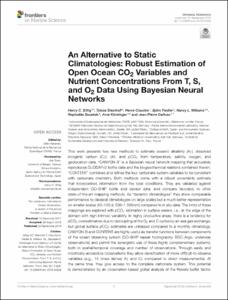| dc.contributor.author | Bittig, Henry C. | |
| dc.contributor.author | Steinhoff, Tobias | |
| dc.contributor.author | Claustre, Hervé | |
| dc.contributor.author | Fiedler, Björn | |
| dc.contributor.author | Williams, Nancy L. | |
| dc.contributor.author | Sauzède, Raphaëlle | |
| dc.contributor.author | Körtzinger, Arne | |
| dc.contributor.author | Gattuso, Jean-Pierre | |
| dc.date.accessioned | 2021-08-09T15:46:22Z | |
| dc.date.available | 2021-08-09T15:46:22Z | |
| dc.date.issued | 2021 | |
| dc.identifier.citation | Bittig, H.C., Steinhoff, T., Claustre, H.,
Fiedler, B., Williams, N.L., Sauzède, R.,
Körtzinger, A. and Gattuso, J-P. (2018)
An Alternative to Static Climatologies:
Robust Estimation of Open Ocean
CO2 Variables and Nutrient
Concentrations From T, S, and O2
Data Using Bayesian Neural
Networks. Frontier in Marine Science, 5:328, 29pp.
DOI: 10.3389/fmars.2018.0032 | en_US |
| dc.identifier.uri | https://repository.oceanbestpractices.org/handle/11329/1662 | |
| dc.identifier.uri | http://dx.doi.org/10.25607/OBP-1591 | |
| dc.description.abstract | This work presents two new methods to estimate oceanic alkalinity (AT), dissolved
inorganic carbon (CT), pH, and pCO2 from temperature, salinity, oxygen, and
geolocation data. “CANYON-B” is a Bayesian neural network mapping that accurately
reproduces GLODAPv2 bottle data and the biogeochemical relations contained therein.
“CONTENT” combines and refines the four carbonate system variables to be consistent
with carbonate chemistry. Both methods come with a robust uncertainty estimate
that incorporates information from the local conditions. They are validated against
independent GO-SHIP bottle and sensor data, and compare favorably to other
state-of-the-art mapping methods. As “dynamic climatologies” they show comparable
performance to classical climatologies on large scales but a much better representation
on smaller scales (40–120 d, 500–1,500 km) compared to in situ data. The limits of these
mappings are explored with pCO2 estimation in surface waters, i.e., at the edge of the
domain with high intrinsic variability. In highly productive areas, there is a tendency for
pCO2 overestimation due to decoupling of the O2 and C cycles by air-sea gas exchange,
but global surface pCO2 estimates are unbiased compared to a monthly climatology.
CANYON-B and CONTENT are highly useful as transfer functions between components
of the ocean observing system (GO-SHIP repeat hydrography, BGC-Argo, underway
observations) and permit the synergistic use of these highly complementary systems,
both in spatial/temporal coverage and number of observations. Through easily and
robotically-accessible observations they allow densification of more difficult-to-observe
variables (e.g., 15 times denser AT and CT compared to direct measurements). At
the same time, they give access to the complete carbonate system. This potential
is demonstrated by an observation-based global analysis of the Revelle buffer factor which shows a significant, high latitude-intensified increase between +0.1 and +0.4 units
per decade. This shows the utility that such transfer functions with realistic uncertainty
estimates provide to ocean biogeochemistry and global climate change research. In
addition, CANYON-B provides robust and accurate estimates of nitrate, phosphate, and
silicate. Matlab and R code are available at https://github.com/HCBScienceProducts/. | en_US |
| dc.language.iso | en | en_US |
| dc.rights | Attribution 4.0 | * |
| dc.rights.uri | http://creativecommons.org/licenses/by/4.0/ | * |
| dc.subject.other | Carbon cycle | en_US |
| dc.subject.other | GLODAP | en_US |
| dc.subject.other | Surface pCO2 climatology | en_US |
| dc.subject.other | Machine learning | en_US |
| dc.subject.other | Revelle buffer factor increase | en_US |
| dc.title | An Alternative to Static Climatologies: Robust Estimation of Open Ocean CO2 Variables and Nutrient Concentrations From T, S, and O2 Data Using Bayesian Neural Networks. | en_US |
| dc.type | Journal Contribution | en_US |
| dc.description.refereed | Refereed | en_US |
| dc.format.pagerange | 29pp. | en_US |
| dc.identifier.doi | 10.3389/fmars.2018.00328 | |
| dc.subject.parameterDiscipline | Carbon, nitrogen and phosphorus | en_US |
| dc.subject.parameterDiscipline | Carbonate system | en_US |
| dc.subject.parameterDiscipline | Nutrients | en_US |
| dc.subject.dmProcesses | Data analysis | en_US |
| dc.bibliographicCitation.title | Frontiers in Marine Science | en_US |
| dc.bibliographicCitation.volume | 5 | en_US |
| dc.bibliographicCitation.issue | Article 328 | en_US |
| dc.description.sdg | 14.a | en_US |
| dc.description.eov | Sea surface temperature | en_US |
| dc.description.eov | Subsurface temperature | en_US |
| dc.description.eov | Sea surface salinity | en_US |
| dc.description.eov | Subsurface salinity | en_US |
| dc.description.eov | Oxygen | en_US |
| dc.description.eov | Inorganic carbon | en_US |
| dc.description.eov | Nutrients | en_US |
| dc.description.adoption | Validated (tested by third parties) | en_US |
| dc.description.methodologyType | Method | en_US |
| dc.description.methodologyType | Specification of criteria | en_US |
| dc.description.methodologyType | Reports with methodological relevance | en_US |
| obps.contact.contactname | Henry C. Bittig | |
| obps.contact.contactemail | bittig@io-warnemuende.de | |
| obps.resourceurl.publisher | https://www.frontiersin.org/articles/10.3389/fmars.2018.00328/full | |
 Repository of community practices in Ocean Research, Applications and Data/Information Management
Repository of community practices in Ocean Research, Applications and Data/Information Management

